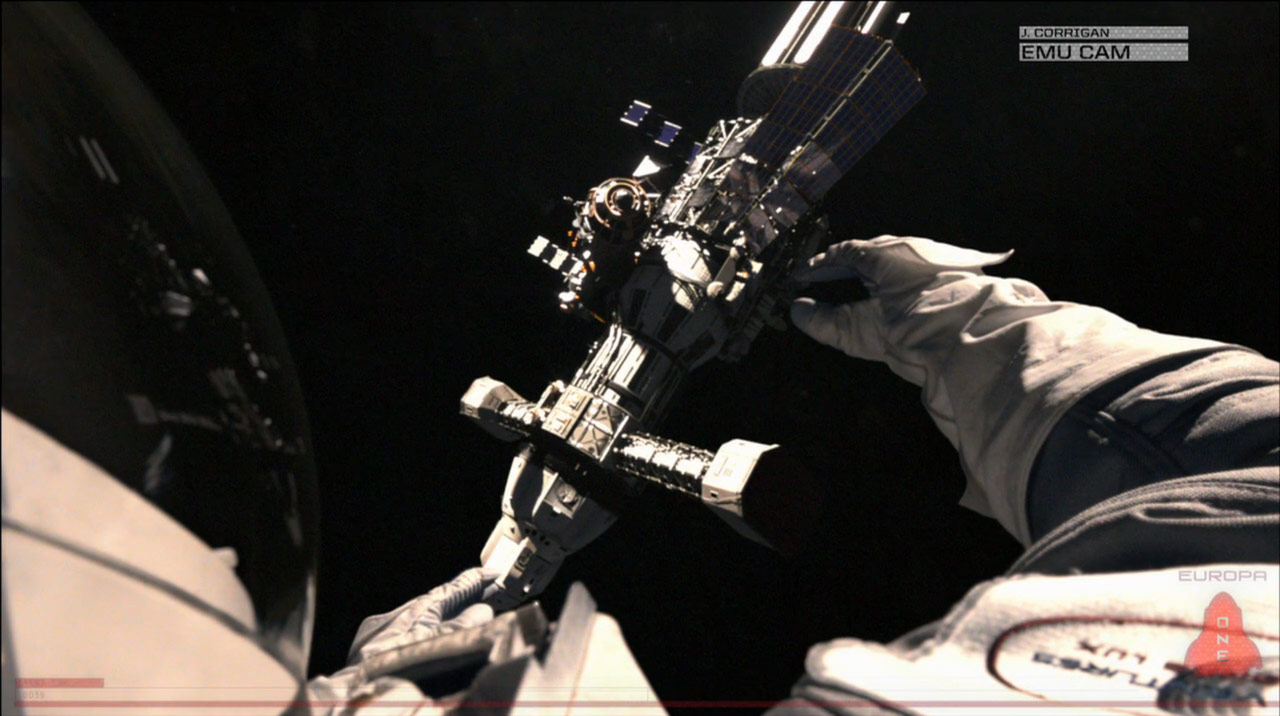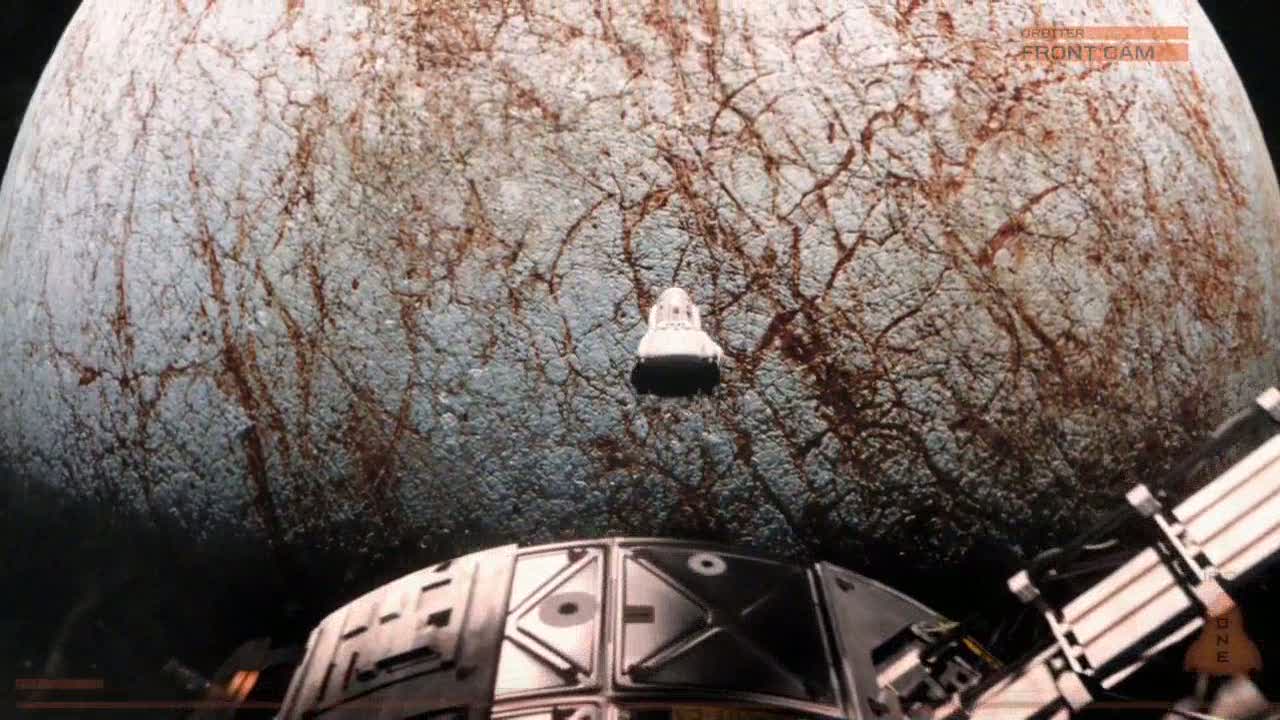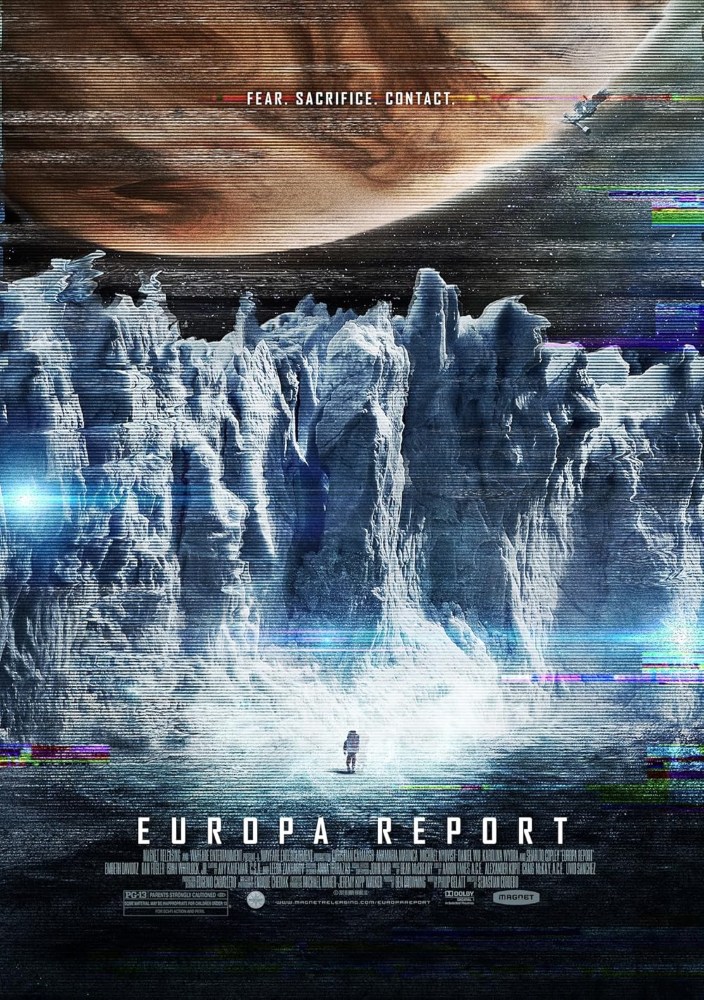USA. 2013.
Crew
Director – Sebastian Cordero, Screenplay – Philip Gelatt, Producers – Ben Browning & Kevin Misher, Photography – Enrique Chediak, Music – Bear McCreary, Visual Effects Supervisor – John Bair, Visual Effects – Look Effects (Supervisor – Jeff Wozniak), Method Studios (Supervisor – Jim Rider), Perception, Phosphene, Quadratic Digital (Supervisor – Brendan Taylor), Special Effects Supervisor – Drew Jiritano, Production Design – Eugenio Caballero. Production Company – Wayfare Entertainment/Misher Films.
Cast
Anamaria Marinca (Rosa Dasque), Michael Nyqvist (Andrei Blok), Sharlto Copley (James Corrigan), Karolina Wydra (Dr Katya Petrovna), Daniel Wu (Captain Dun ‘William’ Xu), Embeth Davidtz (Dr Samantha Unger), Christian Camargo (Dr Daniel Luxembourg), Dan Fogler (Dr Nikola Sokolov), Isiah Whitlock, Jr. (Dr Tarik Pamuk)
Plot
The spaceship Europa One has been despatched on an eighteen month mission to explore Jupiter’s moon Europa and determine the possibility of life in the waters under its frozen surface. However, contact with the six person international crew has been abruptly lost. Mission Control tries to piece together what happened from the on-board video recordings. As becomes apparent, the mission was beset by problems. After making a landing on Europa, various of the crew began to report strange lights and unusual radiation spikes. In trying to investigate these and makes repairs to the ship, accidents began to eliminate the crew’s complement.
Curse you Alfonso Cuaron. Ever since Gravity (2013), it seems that a new bar has been set for the depiction of space and the zero gravity environment on the screen. In this respect, Europa Report suffers in the timing. Even though it came out earlier, I didn’t end up seeing it before Gravity and I am sure if I had I would have enjoyed it a good deal more; it’s just that post-Gravity, it seems a whole lot flatter.
I am always a sucker for hard science based science-fiction. Europa is a fascinating locale in real world science – the sixth moon of Jupiter, it has a surface of frozen ice and it is believed that beneath this is an ocean heated by thermal volcanic vents where there has been much speculation that this could be a source of microbial life. The colonisation of Europa and the idea of life being found there has featured in a number of books before – see the likes of Europa Strike (2000) by Ian Douglas and Galileo’s Dream (2009) by Kim Stanley Robinson. The only film to visit it as a locale was 2010 (1984), the sequel to 2001: A Space Odyssey (1968), where the aliens behind the monolith were terraforming it into a world to allow life to evolve there. The idea of exploring Europa seems an intensely exciting one – of a human ship landing on a moon of ice, even the idea of venturing underneath the ice in some type of submersible in search of alien life.
Unfortunately, soon in, Europa Report becomes disappointing. You get that the film was only being produced on a lesser budget but things become noticeable – the astronauts are simply walking around on a standard terrestrial set for the most part. This is rationalised by showing us exteriors of the ship where sections are rotating thus creating centrifugal gravity, which is demonstrated in one scene where Sharlto Copley floats up the ladder towards the central hub. In some other scenes, we do get people sitting in the control room at 45-degree angles to each other. You can see that the film has clearly cut budget corners – much of it is filled with NASA stock footage (there are dozens of end credits for this), while the model shots and exteriors are kept to a minimum and the space scenes simply take place against a black backdrop with no stars showing. The spacewalk sequence, for instance, is shot in tight closeups and no wide angles.

Certainly, Sebastian Cordero does manage one imaginative sequence that you are surprised Alfonzo Cuaron never thought of – where Sharlto Copley and Michael Nyqvist conduct a spacewalk repair mission, Nyqvist ruptures the glove of his suit on the metal and Copley gets him to the airlock with his hand over the puncture only to realise that he has spilled poisonous hydrazine over his own suit where the only solution would seem to be to get out of his suit in the void of the airlock. The scene culminates on the fine image of Sharlto Coply drifting away from the ship until we see it becomes a tiny dot in the distance from behind his shoulder.
The main problems with Europa Report are its story structure and its method of approach. Firstly, the film sets up a great mystery – the idea of an expedition going to seek life on Europa where something has gone wrong that Mission Control is trying to piece together. Instead though, three-quarters of the film is comprised of the journey to Europa. These sections seem modelled on 2001 – the dullness of life on board where drama is created by a series of ongoing disasters that befall the crew.
The other problem is that the film takes a semi-Found Footage approach – not completely as there are often shots that don’t come from video feed, as well as a musical score added. This gives some severe limitations to the film – as many Found Footage films have discovered, the constant shakycam helps disguise many budgetary shortcomings that allow the film to have to show very little. That leads to the great disappointment of the film that [PLOT SPOILERS] despite enormous build-up to what is causing the radiation spikes and the possibility of life beneath the ice, the only reveal we get right at the end is a shakycam creature with tentacles that can only be clearly seen on a single paused frame of the replay.

What is missing is any of the conceptual possibility inherent in the idea of the meeting of different species, attempts to communicate with the alien or understand its biology that I was hoping the film would delve into. Europa Report ends up being like The Fourth Kind (2009), another quasi-Found Footage effort about alien abductions, which hinted at great mystery but in the end used the Found Footage approach only as smoke and mirrors to obscure the fact that it had an empty hand when revealing any answers. In other words, we have a film that is all promise and zero delivery.
The film certainly manages to bring together a more than reasonable international cast. There is Sharlto Coley, the South African actor from District 9 (2009), with American accent in place and looking the most regular and ruggedly all-American of the group. There are a number of faces that one failed to initially recognise – Embeth Davidtz as the mission head back on Earth; Michael Nyqvist from The Girl with the Dragon Tattoo (2009) as a grizzled Russian scientist who is falling apart; even Dan Fogler from Fanboys (2008) as a scientist. Not to mention Anamaria Marinca, the Romanian actress from 4 Months, 3 Weeks and 2 Days (2007), who plays a coolly androgynous East European astronaut.
Europa Report is the fifth film for Ecuadorian director Sebastian Cordero, the first he has made in English language. Cordero had previously gained some festival play with Cronicas (2004) about a news crew profiling a serial killer and Rage (2009) about a man on the run from a murder, and subsequent to this with Such is Life in the Tropics (2016).
Trailer here


